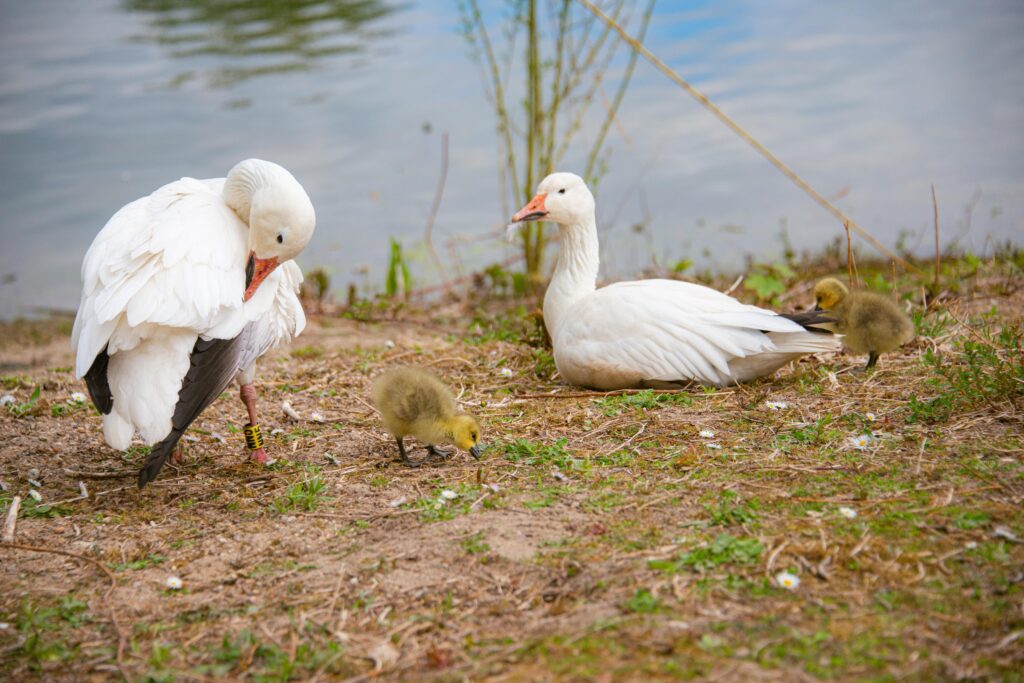Geese are a type of waterfowl and are commonly found in North America. Pennsylvania has two main types of geese: the Canada goose and the snow goose.
Canada Geese
Canada geese have 11 different subspecies and 3 of those subspecies are in Pennsylvania. The primary one is the giant Canada goose. They remain in Pennsylvania year-round, nesting and raising their young here. Canada geese are sometimes referred to as “honkers.”
| Appearance | Canada geese are large and plump, with long, black necks and a round-tipped bill. They have a gray-brown body, a white patch on their cheeks, and a black head, neck, legs, and tail. |
| Length | About 36 inches, with a 60 inch wingspan |
| Weight | About 9 pounds |
| Habitat | Canada geese tend to nest in open fields near bodies of water, on islands, and along rocky cliffs. They will travel great distances to find food. |
| Food | Canada geese eat both wild and cultivated plants. These include: pondweed, eelgrass, American bulrush, algae, clover, wheat, corn, barley, and rye. Canada geese will also sometimes eat crustaceans, insects, and snails. |
| Predators | Eggs: raccoons, opossums, skunks, crows Goslings: foxes, coyotes, hawks, owls, snapping turtles |
| Location in Pennsylvania | Statewide |
| Extra facts | Males are bigger than females. When feeding on land, Canada geese will stay in a group. They have good senses of vision and hearing. A Canada goose’s flight speed can be anywhere from 45 to 60 miles per hour. |
Complaints
Geese can leave large quantities of feces on yards, school grounds, golf courses, etc. They can also eat grasses and crops that can make them unwanted pests. In the springtime, while protecting their eggs and young, they can be quite aggressive and will attack people and pets.
Solutions
Geese are protected by some state and federal laws but they can be harassed with pyrotechnics or trained and well-behaved dogs. Their eggs can be addled (shaken) or oiled so that the young do not hatch but the female goose will continue to sit on the eggs until the egg laying season is over. This will not eliminate the adult pair but it will reduce the size of the flock.
Snow Geese
Snow geese are one of the world’s most abundant species of waterfowl. During the spring and summer, snow geese will breed in arctic regions. They will then migrate south for the winter to inland and coastal areas, including Pennsylvania. There are 2 subspecies of snow geese: the greater snow goose and the lesser snow goose.
| Appearance | Snow geese are medium-sized birds with white feathers and black wingtips. Lesser snow geese sometimes go through what’s known as the blue phase, where they have gray or brown feathers on their bodies. |
| Length | Anywhere from 27 to 33 inches, with a 54 inch wingspan |
| Weight | Ranging from 3.5 to 7 pounds |
| Habitat | Snow geese tend to spend their summers around rivers, islands, and sections of the arctic tundra with ponds. They spend their winters in areas that are clear of snow and do not flood in the spring. |
| Food | Leafy parts of grasses, sedges, and rushes, aquatic plants, barley, berries, corn, grains and wheat |
| Predators | Eggs: gulls, ravens, crows Goslings: coyotes, foxes |
| Location in Pennsylvania | Southeastern PA |
| Extra facts | Male and female snow geese form lifelong pair bonds. Both parents will help to raise the young. Snow geese are good at swimming and will dive under water to avoid predators. They have flying speeds up to 50 miles per hour. Snow geese sleep on the water. |

For more information about Canada geese and snow geese, check out the Pennsylvania Game Commission’s wildlife notes.
